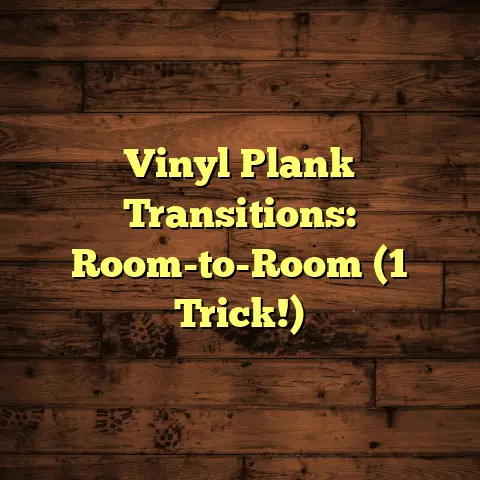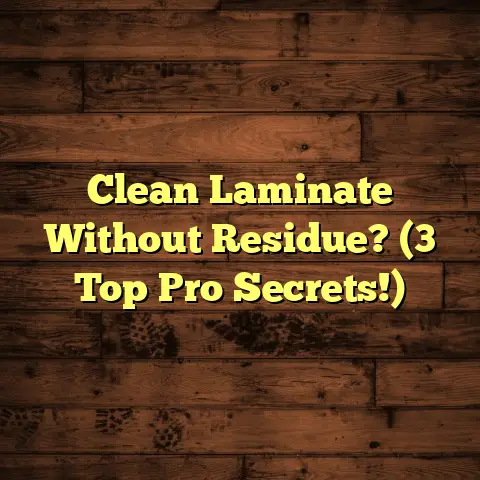Bleach on Wood Floors? (5 Floor Fails!)
That warm, inviting feeling? It’s priceless.
But here’s the deal: like any investment, wood floors need love and care to stay looking their best.
And that’s where things can get tricky. I’ve seen too many homeowners reach for the bleach, thinking it’s a quick fix for stains or discoloration.
Trust me, it’s not!
Bleach on wood? It’s a recipe for disaster. In this article, I’m going to walk you through five major fails that can happen when bleach meets your precious wood floors.
We’ll talk about why it’s so bad, what you can do instead, and how to keep your floors looking amazing for years to come.
Let’s dive in!
Section 1: Understanding Wood Floors and Their Vulnerabilities
1.1 The Composition of Wood Flooring
Okay, first things first, let’s talk about what your wood floors are actually made of. It’s not all the same!
You’ve got two main types: solid hardwood and engineered wood.
Solid hardwood is exactly what it sounds like: one solid piece of wood, usually about ¾ inch thick. It’s durable, can be refinished multiple times, and adds real value to your home.
Engineered wood, on the other hand, is made up of layers. Think of it like plywood, but with a beautiful hardwood veneer on top.
It’s more stable than solid wood (less likely to warp with changes in humidity) and often more affordable.
Now, let’s talk about finishes. This is the protective layer that sits on top of the wood and determines its look and feel.
You’ve got oil-based finishes, which are durable and give a warm, amber tone.
Then there are water-based finishes, which are more eco-friendly and dry clear. And let’s not forget polyurethane, a super-tough synthetic finish that’s popular for high-traffic areas.
The thing is, all these finishes react differently to chemicals, and bleach is one of the harshest out there.
1.2 Common Issues Faced by Wood Floors
So, what are the usual suspects when it comes to wood floor problems?
Well, stains are a big one. Spilled wine, pet accidents, muddy footprints – they can all leave their mark.
Scratches are another common issue, especially if you have pets or kids. And then there’s water damage, which can cause warping, cupping, and even mold growth.
Now, when faced with these problems, it’s tempting to reach for the strongest cleaner you can find, right?
And that’s where bleach comes in. It seems like a powerful, all-purpose solution. But trust me, it’s a wolf in sheep’s clothing.
It might seem like a quick fix, but it can cause way more problems than it solves. Let’s see how, shall we?
Section 2: Fail #1 – Discoloration and Damage to the Finish
2.1 How Bleach Affects the Finish
Alright, let’s get down to the nitty-gritty of why bleach is so bad for your wood floor’s finish.
Bleach is a powerful oxidizing agent. That means it breaks down the chemical bonds in the finish, causing it to fade, discolor, or even completely strip away.
Imagine you have a beautiful, dark-stained hardwood floor. You spill something, panic, and grab the bleach.
What happens? The bleach starts to eat away at the stain, sure, but it also starts to lighten the surrounding wood.
You end up with a patchy, uneven mess that looks way worse than the original stain. And the worst part?
It’s often irreversible.
Different finishes react differently, but none of them like bleach. Oil-based finishes can become cloudy and dull.
Water-based finishes can peel and crack. And polyurethane can become brittle and yellow.
It’s a lose-lose situation.
2.2 Real-Life Case Study
I remember one time, a homeowner called me in a panic. She had spilled some red wine on her brand-new oak floors and, in a moment of panic, poured bleach on it.
When I arrived, the damage was extensive. The bleach had not only removed the stain but had also created a large, bleached-out patch that looked completely out of place.
The only solution was to sand down the entire floor and refinish it, a costly and time-consuming process.
She learned a very expensive lesson that day: bleach and wood floors don’t mix.
Section 3: Fail #2 – Structural Weakening of the Wood
3.1 The Impact of Bleach on Wood Integrity
So, bleach doesn’t just mess with the finish, it can also weaken the wood itself.
How? Well, wood is made up of cellulose fibers held together by lignin.
Bleach attacks both of these components, breaking down the wood’s structure at a microscopic level.
When bleach seeps into the wood fibers, it causes them to become brittle and weak.
Over time, this can lead to warping, cracking, and even softening of the wood. Imagine walking across your floor and feeling it give way beneath you.
Not a good feeling!
And the more often you use bleach, the worse the damage becomes. It’s a slow, insidious process that can eventually compromise the entire floor.
3.2 Illustrative Example
Let’s say you have a persistent mildew problem in your bathroom. You decide to regularly clean the floor with a bleach solution to keep the mildew at bay.
At first, it seems like it’s working. But over time, the bleach weakens the wood around the edges of the tiles.
The wood becomes soft and spongy, and eventually, the tiles start to come loose. Before you know it, you have a major structural problem on your hands, all thanks to the bleach.
The cost to repair the floor? Significantly more than if you had used a proper mildew cleaner in the first place.
Section 4: Fail #3 – Chemical Residue and Indoor Air Quality
4.1 Lingering Chemicals in Your Home
Here’s another reason to avoid bleach on your wood floors: it can leave behind harmful residues that affect your indoor air quality.
Bleach contains chlorine, a powerful irritant that can cause respiratory problems, skin irritation, and even headaches.
When you use bleach on your floors, some of it inevitably gets left behind. As it evaporates, it releases chlorine fumes into the air, which you and your family then breathe in.
And the problem is even worse if you have young children or pets, who spend a lot of time close to the floor.
They’re more likely to be exposed to the fumes and residues, which can be especially harmful to their developing lungs.
According to the EPA, even low levels of chlorine exposure can cause:
- Coughing
- Wheezing
- Shortness of breath
- Sore throat
- Eye and skin irritation
4.2 Personal Testimony
I had a client once who was convinced that her family’s persistent coughs and allergies were caused by mold in their home.
After a thorough inspection, I discovered that the real culprit was the bleach she was using to clean her wood floors.
She had been using it regularly for years, and the chlorine fumes had been irritating her family’s respiratory systems.
Once she switched to a bleach-free cleaner, their symptoms gradually disappeared. It was a real eye-opener for her, and for me.
It just goes to show that sometimes, the solutions we think are helping us are actually making things worse.
Section 5: Fail #4 – Increased Maintenance Costs
5.1 The Financial Impact of Mistakes
Let’s talk about money. Using bleach on your wood floors can end up costing you a lot more than you think.
As we’ve already discussed, bleach can damage the finish, weaken the wood, and create health problems.
All of these issues can lead to costly repairs or even complete floor replacement.
Think about it: if you bleach your floors and end up with discoloration or structural damage, you’ll likely need to hire a professional to sand down and refinish the entire floor.
That can easily cost thousands of dollars, depending on the size of your home and the type of wood you have.
And if the damage is severe enough, you might even need to replace the entire floor, which can cost tens of thousands of dollars.
According to HomeAdvisor, the average cost to install hardwood floors is between $6 to $12 per square foot.
So, a 1,000-square-foot floor could cost you $6,000 to $12,000 to replace!
Is saving a few bucks on bleach really worth that risk?
5.2 Comparison with Correct Cleaning Practices
Now, let’s compare the costs of bleach-related damage with the costs of proper cleaning methods.
A good quality wood floor cleaner will typically cost you around $10 to $20 per bottle.
And if you use it regularly, it will help to protect your floor’s finish, prevent damage, and keep it looking its best for years to come.
According to the National Wood Flooring Association (NWFA), you should clean your wood floors at least once a week with a pH-neutral cleaner.
That might seem like a lot, but it’s a small price to pay for keeping your floors in top condition.
So, instead of risking costly repairs with bleach, invest in a good quality cleaner and follow the manufacturer’s instructions.
Your floors (and your wallet) will thank you for it.
Section 6: Fail #5 – Loss of Aesthetic Appeal
6.1 How Bleach Alters Appearance
Okay, let’s be honest: one of the main reasons we love wood floors is because they look beautiful.
They add warmth, character, and value to our homes. But bleach can completely ruin that aesthetic appeal.
As we’ve discussed, bleach can cause discoloration, staining, and an overall uneven appearance.
It can fade the natural color of the wood, leaving it looking washed out and unnatural.
It can also create unsightly blotches and streaks that are impossible to remove.
And even if you manage to get rid of the stain, the bleach can still leave behind a dull, lifeless finish that detracts from the overall beauty of the floor.
Imagine you have a gorgeous, hand-scraped hardwood floor with a rich, warm tone.
You spill something, reach for the bleach, and end up with a large, bleached-out patch that looks completely out of place.
Suddenly, your beautiful floor becomes an eyesore, and the entire room loses its appeal.
6.2 Case Illustrations
I’ve seen countless floors that have been ruined by bleach.
I’ve seen dark-stained floors with large, bleached-out patches.
I’ve seen light-colored floors with unsightly yellow stains.
And I’ve seen floors that have been so badly damaged by bleach that they had to be completely replaced.
The common thread in all these cases? A well-intentioned homeowner who thought bleach was a quick and easy solution.
They didn’t realize the damage it could cause, and they ended up paying the price.
Don’t let that happen to you.
Protect the beauty of your wood floors by avoiding bleach and using proper cleaning methods.
Conclusion: Emphasizing Proper Care and Maintenance
So, there you have it: five major fails that can happen when you use bleach on your wood floors.
From discoloration and structural weakening to chemical residue and loss of aesthetic appeal, the risks far outweigh the benefits.
While bleach may seem like a convenient solution for stains and spills, it can cause irreversible damage that costs you time, money, and the beauty of your home.
Instead of reaching for the bleach, invest in a good quality wood floor cleaner and follow the manufacturer’s instructions.
Clean up spills immediately, use mats and rugs in high-traffic areas, and protect your floors from excessive moisture.
By taking these simple steps, you can keep your wood floors looking their best for years to come.
And if you’re ever unsure about how to clean or maintain your floors, don’t hesitate to consult a professional.
We’re here to help you keep your floors looking beautiful and your home healthy.
After all, your floors are the foundation of your home. Take care of them, and they’ll take care of you.





